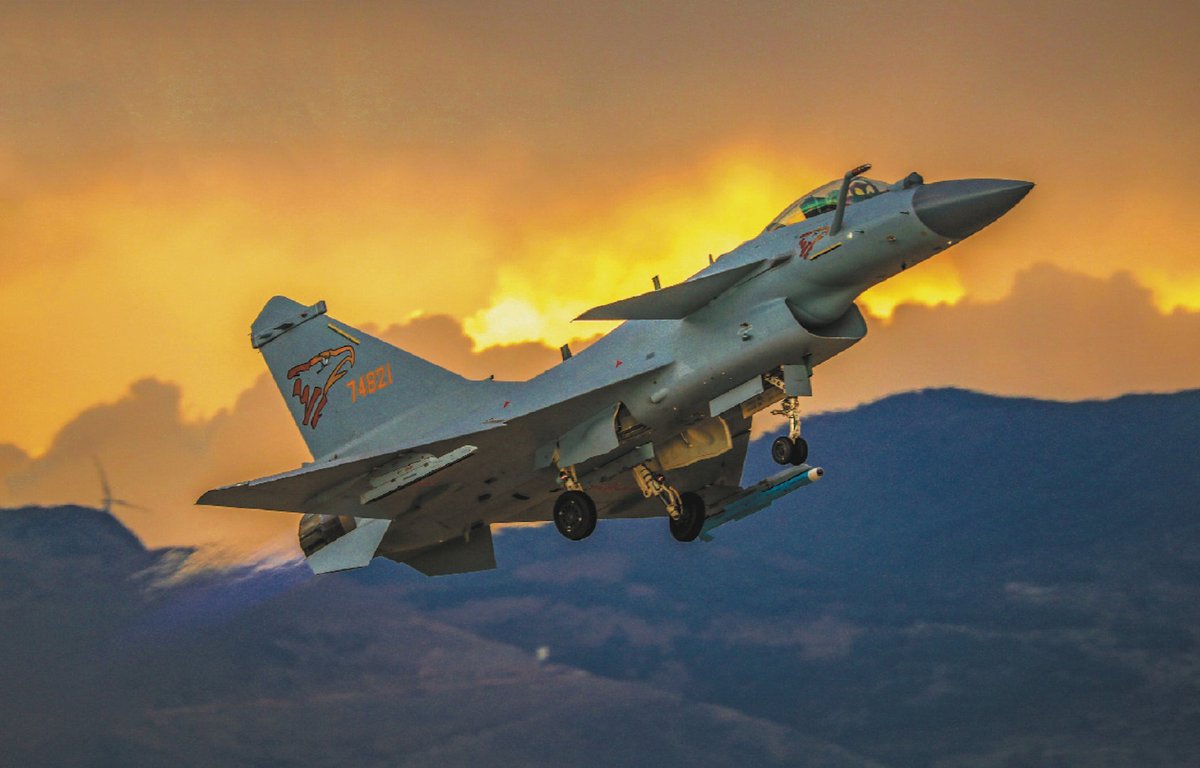Playing catch up with two military superpowers – the United States and Russia, China has switched to a J-10C for performing flight displays, making it the third country to make the big switch and deploying a 4+ generation aircraft for conducting ‘aerobatic’ in an airshow.
The Chinese People’s Liberation Army (PLA) Air Force’s Bayi Aerobatic Team has switched to flying J-10C fighter planes and will do its debut performance with the new aircraft overseas at an upcoming maritime and aerospace display in Malaysia, state-owned media Global Times reported.
Chinese experts told the media on May 16 that China’s employment of the J-10C for conducting overseas displays demonstrates the PLA Air Force’s confidence and openness to the rest of the world.
The use of advanced fighter jets in these aerobatic maneuvers is considered a risky proposition, given the several accidents witnessed globally while conducting flight displays.
Most countries often press their older generation or light/trainer aircraft for flight displays. China’s Ba Yi aerobatics team, also known as the August 1st team, used its second-generation J-7GB Supersonic jets (a modified variant of a Russian MiG-21) to participate in flight displays. In 2015, the J-7GBs were replaced by the J-10s, a fourth-generation fighter jet.
The Ba Yi aerobatics team, with its six J-10s, took to the skies at the Zhuhai Air Show in 2022 and performed some exciting aerial maneuvers, such as formation changes and loops, with dazzling smoke trails across the sky.

Just over five years after the J-10s entered the Ba Yi team, the PLA Air Force has now switched to J-10C fighter jets, which have been significantly upgraded and qualify as 4.5th generation aircraft.
The adoption of J-10C comes a week before the team’s scheduled participation in Malaysia’s 16th Langkawi International Maritime and Aerospace Exhibition (LIMA) from May 23 to 27.
According to Zhang Xuefeng, a Chinese military analyst, the J-10C is redesigned from the J-10A/S to have a supersonic diverters inlet and a revised nose cone to optimize the aerodynamic design.
Zhang further said the J-10C received enhancements to its avionic equipment, including the radar system, and added an infrared search and track system, putting it half a generation ahead of the J-10A in terms of its overall combat capacity.
According to a recent CCTV report, the J-10C used by the Bayi Aerobatic Team differs from the J-10C currently used by combat troops in several ways, including the installation of an expanded spine. Experts also told the state media that the broad spine could accommodate more electronics or fuel and may help enhance the stability of the aircraft.
Another Chinese military analyst Fu Qianshao told the Global Times that the J-10C has a Taihang engine produced locally in China. According to Fu, the locally developed engine’s increased thrust and better controllability will enable the aerobatic team to perform more jaw-dropping maneuvers.
The J-10C will make its debut at the exhibition by the Bayi Aerobatic Team, and analysts anticipate that it will showcase the aircraft’s exceptional capabilities and the pilots’ exquisite talents. But most importantly, it will allow the country to enter an elite club of countries that dispatch their advanced and expensive fighter jets to perform breathtaking aerial maneuvers.
US, Russia Lead The Race
Boasting massive and technologically advanced air forces, Russia and the United States have several aerobatic teams that regularly participate in air shows in their country and abroad.
While some of these teams still operate fourth-generation fighters, others have switched to the mighty 4.5th generation and even the 5th-generation fighter jets (only in the US).
For instance, the Russian Knights team, which operated the Su-27 Flanker and some of its more upgraded variants earlier, switched to the powerful 4+ generation Su-30SM in 2016 and Su-35S fighter jets in 2019 to conduct stunning flight displays. Currently, the team has eight of each aircraft.
In 2017, the Su-30SM was one of the star performers at the 2017 edition of the Dubai Air Show. In the video below, four Su-30SM aircraft could be seen flying in very close formations and displaying graceful arcs, rolls, and loops, leaving the audience mesmerized.
The Su-30SM, an upgraded variant of the base Su-30 model, can climb at a blistering 45,275 feet per minute and fly at Mach 2 thanks to its two afterburning Saturn AL-31FL turbofans, each of which can provide 27,560 pounds of torque. This makes the aircraft performing aerial maneuvers a treat to watch for the onlookers.
In the same 2017 edition of the Dubai Air show, the Russian Su-35S took to the skies over Dubai to showcase its super maneuverability capabilities, which is the most defining feature of this 4+ generation aircraft.
The Su-35 could be seen in the above video, demonstrating post-stall agility through thrust-vectoring engines and an advanced fly-by-wire flight control system.
Later, in MAKS Air Show 2021, the Su-30SM stunned the audience again as the pilots performed formation tailslide, close-coupled formation flight, take-off and landing, high energy bleed WVR dogfight mockup, and plenty of post-stall solo maneuvers.
The United States, on its part, has several aerobatics teams which clock hectic schedules annually and attract huge audiences to their airshows. The US Navy’s ‘Blue Angels’ aerobatic squad, comprising the F/A-18E/F 4.5th generation fighter jets, is among the most popular globally.
The US switched from the Hornets to the Super Hornets only in 2020.
During their aerobatic display, the six-person team flies F/A-18E Super Hornets, divided into the diamond formation (Blue Angels 1 through 4) and the Lead and Opposing Solos (Blue Angels 5 and 6). The Diamond Formation and the Solos’ maneuvers alternate for most of the performance.
In the video shown below, the Super Hornet of the Blue Angel team could be seen performing an extremely low pass which is touted to be a challenging maneuver and calls for very skilled pilots.
Moreover, the US also has one demo team for its F-22 and F-35 fifth-generation fighter jets. However, Russia and China have yet to include their fifth-generation fighters in aerobatic teams performing risky and adventurous aerial maneuvers.
- Contact the author at sakshi.tiwari9555(at)gmail.com
- Follow EurAsian Times on Google News




